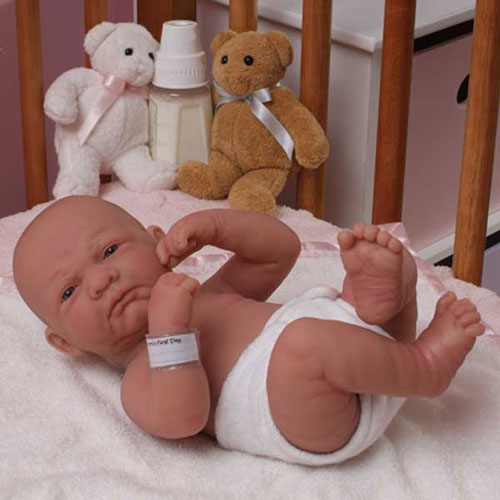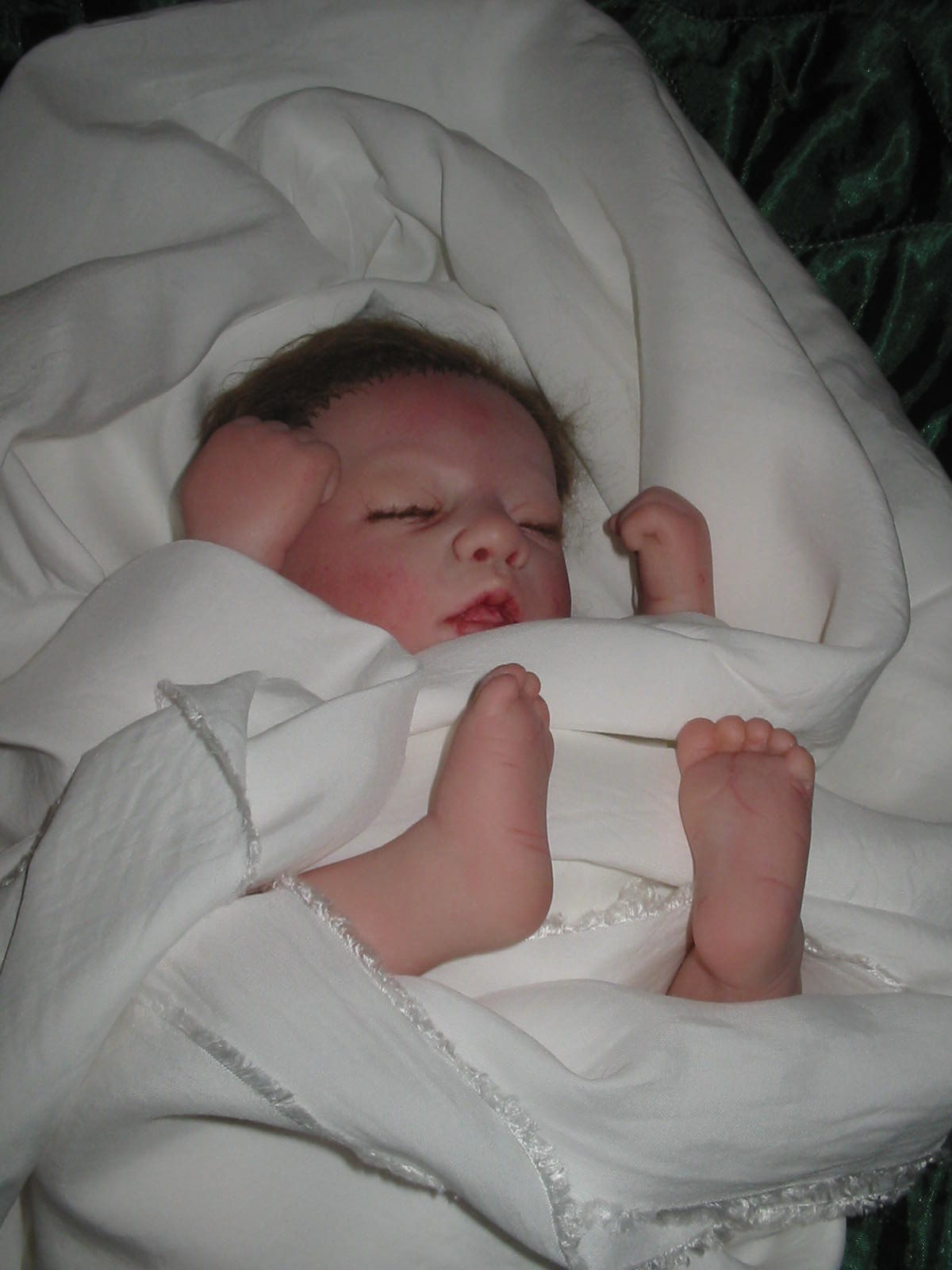At Nightmare’s Edge, Lifelike Dolls

By Eve Bigaj
Staff Writer
20/10/2020

Picture Credit: Reborn dolls
I want to stroke Alma’s silky whisp of hair, put ointment on her peeling ankles, kiss the place where a drop of blood has dried on her teeny heel. I keep scrolling. Eloisa stares at me with vacant green eyes, her fists delightfully wrinkled but eerily glossy. I keep scrolling. Red-eyed and deathly pale, Isadora makes my heart stop. Beneath her button nose, the minuscule mouth dribbles blood, sports fangs.
Adopted, the caption reads. Painted and designed by an 11-year-old – under her mother’s supervision – Vampire Isadora was sold at a discount.
At reborns.com, anyone can become a happy parent. With the help of a dropdown menu, you can narrow down the 657 lifelike dolls by price ($100-$5000), ethnicity, gender, eye material (glass, acrylic, polyglass). Select “boo boo,” and the faces scrunch into pouts. Choose “realborn,” and the vampires, chimpanzees, and waxy misproportioned monstrosities all blessedly disappear – replaced by something which, in its own way, is even eerier: dolls made from 3D-printed babies. (Where do the models for the dolls come from? Bountiful Babies, the top supplier of 3D-printed doll parts, is suing dollmaker Stephanie Ortiz for libel over alleged ties to the Kingston Clan, of polygamy and child marriage fame.)
Reborns.com lies deep in the uncanny valley: that terrifying twilight zone whose residents appear almost-but-not-quite human. Is this website a Toys“R”Us or a slave market? Are these dolls babies or playthings, dead or alive? Unable to settle on a characterization, my mind churns; my stomach churns with it.

Picture Credit: teadrinker
Not everyone feels that way, though. The community of hyperrealistic doll enthusiasts has been steadily growing since 1989, when Joyce Moreno created the first “reborn” doll. The original process of “reborning” involved stripping store-bought dolls of their paint to give them a more lifelike makeover. These days, most artists use unpainted, purpose-built doll kits instead, but the name has stuck.
There are now tens of thousands reborn artists and collectors worldwide. They chat on specialized forums and buy the dolls on eBay, Etsy, Facebook, even walmart.com.
Rather than being put off by ambiguity, the reborn community appears to thrive on it. A reborn “mother” might find her baby at a convention, displayed next to bags of disembodied, unpainted doll parts. She won’t mind knowing that the womb this doll came from was the oven which helped set the paints.

Picture Credit: Donna Lee Originals
Or perhaps she had her baby shipped by mail from an online “nursery.” In this case, she might post a carefully choreographed unboxing video on YouTube. Like a mother at a baby shower, she’ll coo over the accessories that come with the purchase: the cardigans, onesies, itty-bitty shoes. Then comes the birth certificate, and finally: the doll itself. Tradition dictates that the feet are unwrapped first, precious toes squeezed while the head and torso remain swaddled in a blanket. Unboxing complete, the new mom might cradle and rock the doll like a real baby, even change its diapers – only to plonk it unceremoniously to the ground, the neck lolling back as if snapped.
***
Who are the people who collect these dolls? Why do they do it? And with a lifeless baby in the house, how do they sleep at night?
Most (though by no means all) reborn collectors are American or European women. Reborns are mostly white, so many of their collectors (who often refer to dolls of other races as “ethnic”) probably are too. About half have real children. Beyond that, every collector’s story is different.
Shane Pointon’s reborn was modelled on his stillborn son. The father, who burst into tears when receiving the doll from his wife, delights in combing its hair and choosing its outfits. This is the sort of story you’ll find in the tabloids, but Pointon is hardly your typical collector; one reborn artist reports serving a single bereaved customer over seven years. In the minority of cases in which a reborn is based on photos of a real baby, the tragedy prompting the rebirth is usually only this: the prototype had gone on to become an adult, sometimes, the very adult requesting the reborn: more than one son has gifted his mother a reborn version of his baby self.
Many, perhaps most, collectors see themselves as just that: collectors of world-class masterpieces. The artistry really is spectacular; Vermeer would be put to shame by the 30 layers of paint a reborn artist might use to mimic skin over veins. Small touches complete the illusion: individually rooted hairs, heartbeat and voice modules, baby scents.
Vermeer would be put to shame by the 30 layers of paint a reborn artist might use to mimic skin over veins.
Some display the dolls in cribs; others arrange their vinyl babies in glass cases. Kellie Eldred prefers to think of the dolls as “huggable works of art.” She cradles her masterpieces to decompress at the end of a long day at work; nothing soothes your nerves quite like the sensation of holding a pellet-weighted doll.
***
“When you go out and push a pram, everybody looks…You feel seen when you’ve got a baby. I can walk down the street now and nobody looks at you, nobody talks to you.”
Christine was the one who cut her grandson Harry’s umbilical cord. She was his primary caretaker for 2.5 years, while his mother battled from cancer. Then the mother recovered, snatched Harry, and immigrated from the UK to New Zealand.
It’s time to take out the stroller; Christine has had Harry reborn.
For 2.5 years, Christine had a purpose, an identity. And just like that, it was snatched away. For other mothers (birth or not), the transition is less abrupt, but who’s to say it shouldn’t hurt too?
I think back to the sons who reborn themselves for their mothers. I’m your baby – the best gift you can have. I first saw it as infantile egoism. Now, I sense a tenderness beneath the strangeness: he understands his mother’s loss. For years, she had tethered herself to his development; nobody checked whether she was dizzied by its speed. He doesn’t see himself as a baby, but a part of her always will. He is finally old enough to understand this.
The next moment, I’m spooked again. What will Harry think when his grandmother shows him his doppelgänger? If you can replace me with a doll, did you ever really love me?
Reborners have a penchant for bluntness. The doll, unlike a real child, won’t grow up, won’t do drugs, won’t move to New Zealand, won’t die of leukemia. This is all said explicitly. “Let’s be honest, children are cutest when they’re newborns. We all want them to stay that way.”
The doll, unlike a real child, won’t grow up, won’t do drugs, won’t move to New Zealand, won’t die of leukemia.
Reborns “don’t give you any trouble,” collector Lachelle Moore sums up. “There’s no college tuition, no dirty diapers…Just the good part of motherhood.” To hear this as a onetime child is to feel, literally, objectified. It’s to become nothing more than the trigger for the secretion of maternal instincts. Whatever happened to loving a child’s interior? To watching and helping a baby become her own person? Is none of that part of what makes motherhood worthwhile?
Reborning shines a blinding light on parenting’s dark side. Our parents did want to hold on to us forever; a part of them did, anyway. And still, they let go. That is love.
***
When Christine brought “Harry” back home, her husband couldn’t hide his revulsion. “It’s like something out of the mortuary!” he protests. The quiver of Christine’s lip is barely perceptible, but it stings more than the sharpest accusation. For all the sympathy I have come to feel for these collectors, I remain repelled by the reborns themselves. Why must the dolls look so alive – and hence so dead? Why can’t their owners play with ragdolls instead?

Picture Credit: michelle a
It’s tempting to say: to better inhabit their fantasy. But despite all the talk of “adoption,” for all the diapers and doll-strollers, it would be a mistake to accuse reborn collectors of delusion – and not just because they themselves deny that the dolls are real babies.
Do you believe in a movie’s fiction when you watch it? What if you’re engrossed in a gripping scene? These collectors embrace their dolls in a similar way.
When Lucenda Plancarte sits with her dolls, she is also sitting with her infertility. What Shane Pointon, the grieving father, takes out of the wrapping paper is a fantasy child and the reality of his son’s death. When Christine puts her newborn in a stroller, she imagines he is Harry even as she learns to accept that he isn’t.
The very feature of reborns which repels me – their residence at the edge of the uncanny valley – is what allows their owners to move through their grief. The doll is an infant one moment, and just a doll the next; the owner can escape her grief for an instant, then be brought right back.
The very feature of reborns which repels me – their residence at the edge of the uncanny valley – is what allows their owners to move through their grief.
More than their mindboggling realism, this is what makes reborns art to me. Like the most beautiful tragic play, they connect their audiences to their sealed-off feelings, offer solace, so that, fortified, they can return to reality.
***
After hours of polishing this article, I look in the mirror and see…a doll. A physical mechanism which will one day fail me; a bone-sack which can kill each dream through infertility, illness, death.
What if I’m wrong? What if the illusion lies in finding these babies creepy, not cute? What if I, not the collectors, am the escapist?
If something out of a mortuary looks cute, then something cute can end up in the mortuary. I can’t bear to face this conclusion – the staggering fragility of babies – so I deny reborns their cuteness.
The uncanny valley exists because our brains abhor ambiguity. We want an impassable boundary between fact and fiction, the human and the inhuman, the living and the dead. Of course, no such boundary exists; we are all sliding towards the uncanniest of valleys: death.
There is no place to dream but at the nightmare’s edge.
Related posts:
